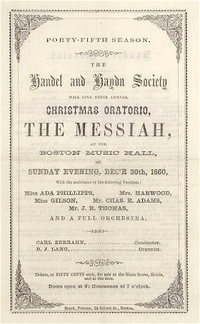DECEMBER 8, 2022 – I’m not a religious person, but I like Christmas for all its traditions, religious and secular.
My personal Christmas music traditions are: 1. Playing by ear on the piano, four or five traditional carols; and 2. While working on my laptop, listening to various YouTube versions of Handel’s Messiah. I know these traditions are corny, but they make me feel as if I were all decked out with holly.
Like a billion musicians the world over, I’ve played in performances of Messiah, though not a gazillion times, as have millions of music-makers. For many of those millions, the annual grog—I mean slog—through Messiah is about as exciting as putting socks on for the umpteenth thousandth time. But as a member of the masses, I still draw inspiration from familiar music, at least when its rendered well.
For three years of my youth I received a heavy direct dose of Messiah. In early December our orchestra (Interlochen Arts Academy) would travel several hours south from the northwest reaches of Michigan’s southern peninsula to the main University of Michigan campus in Ann Arbor. For a day or two we’d rehearse in Hill Auditorium, then perform Messiah in full with the Michigan Choral Union and a line-up of acclaimed soloists.
I’ll never forget the first year. About a week before “Messiah week,” I dreamt I was with our orchestra performing a Baroque piece in an unfamiliar hall. The most memorable detail of the dream was the stage flooring—beautiful, narrow, hardwood strips. Before the dream I’d never been to Hill Auditorium, never seen photos of it, never heard anyone describe it. When in reality we walked on stage for our first rehearsal, the first thing I noticed was the beautiful flooring—just as it had appeared in the dream.
Messiah as a traditional Christmas oratorio is interesting—and not entirely “correct.” Born in 1685—the same year as J. S. Bach—Handel wrote the work in just 24 days in late summer, 1741. It was first performed in Dublin in April and again in June, 1742. To this day in Europe, the work is performed generally during Lent, not Christmas. In 1815, a group of musicians in Boston formed the Handel and Haydn Society to showcase oratorios. For their Christmas concert that year, they sang the Hallelujah! chorus from Messiah. Three years later, the ensemble performed the entire work. Thereafter, it became an American Christmas tradition.
Moreover, it was the Americans who started the tradition of standing for Hallelujah! Over time a legend formed that attributed the tradition to King George II who’d allegedly stood for the chorus—because he was deeply moved by it or . . . was simply trying to relieve a flareup of gout. When the King stood, everyone in his presence was supposed to stand. Thus began, the legend goes, the Stand-up! tradition for Hallelujah!
Not true, it turns out—about the King: he wasn’t even present for the performance at which he’s alleged to have stood. Nowhere else in the world besides America do audiences stand for Hallelujah! But if you’re in a hall or church where Messiah is sung during Advent, when the performance reaches Hallelujah! stand up for an American tradition—and sing with reckless abandon . . . in keeping with another American tradition.
(Remember to subscribe to this blog and receive notifications of new posts by email.)
© 2022 by Eric Nilsson
